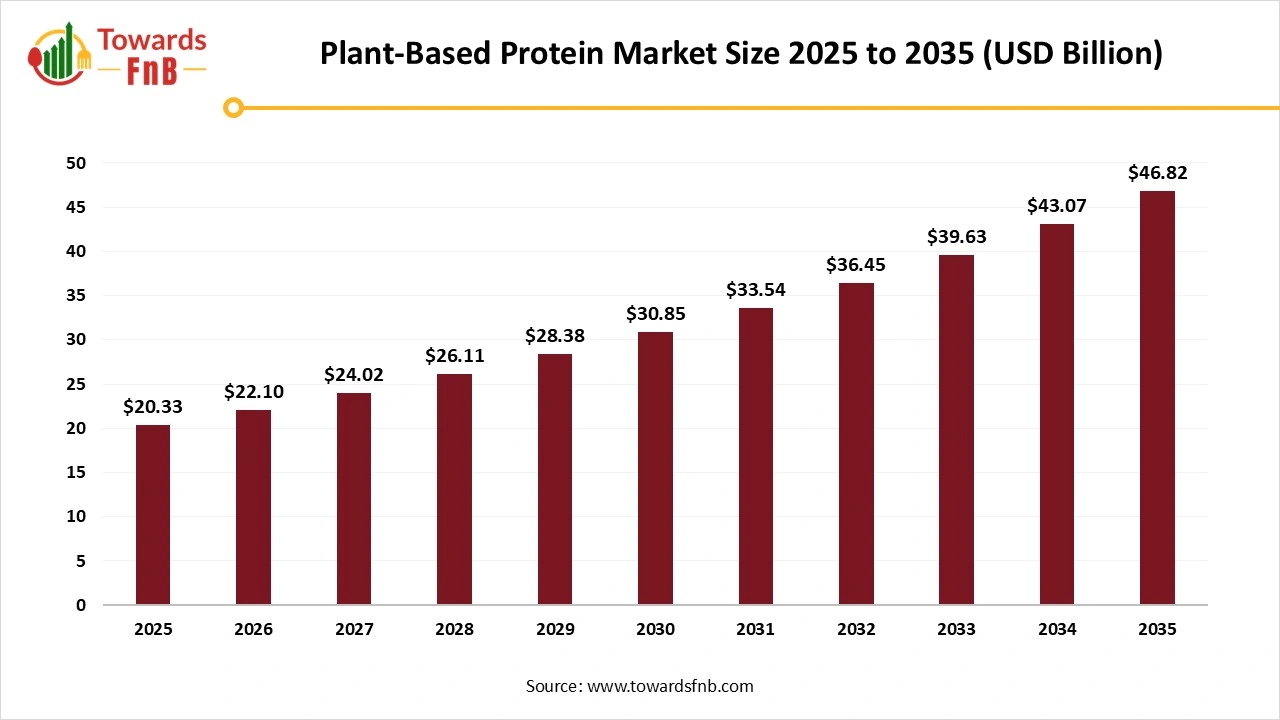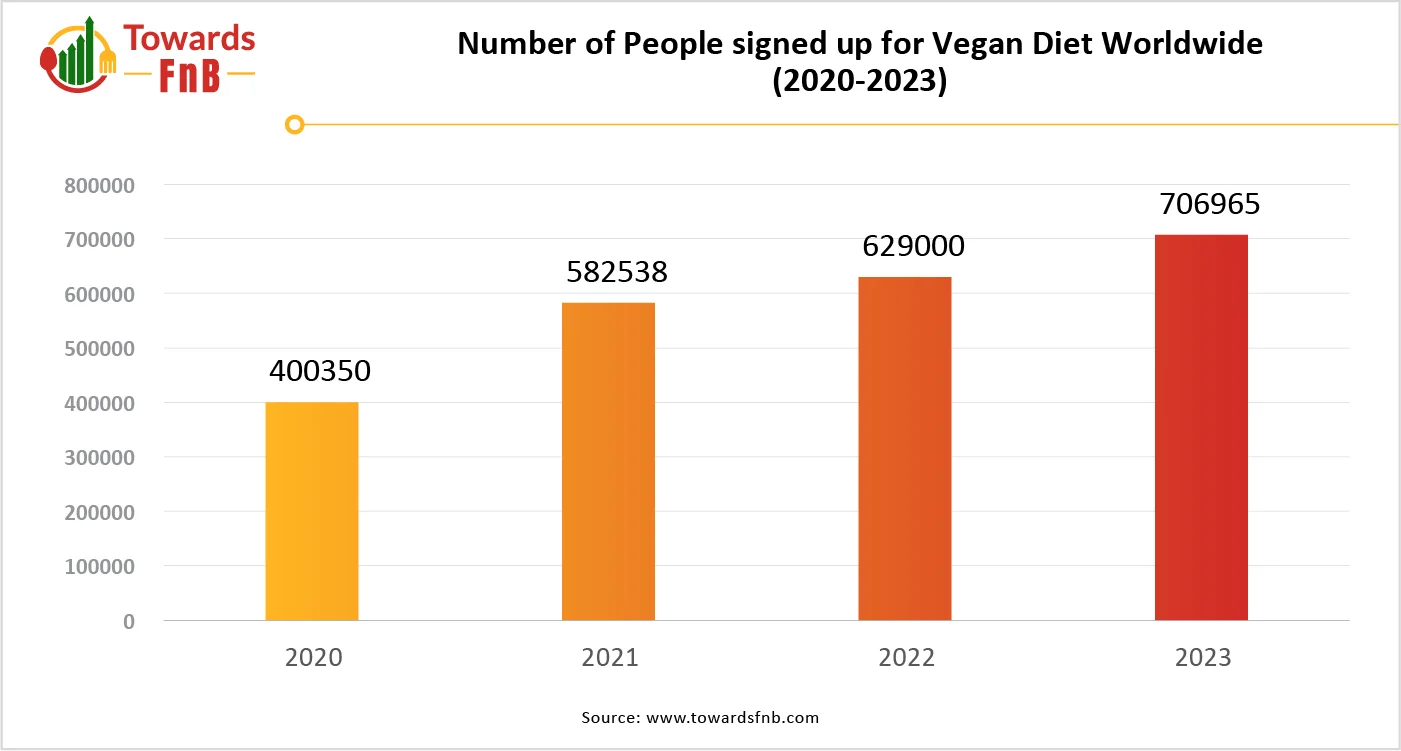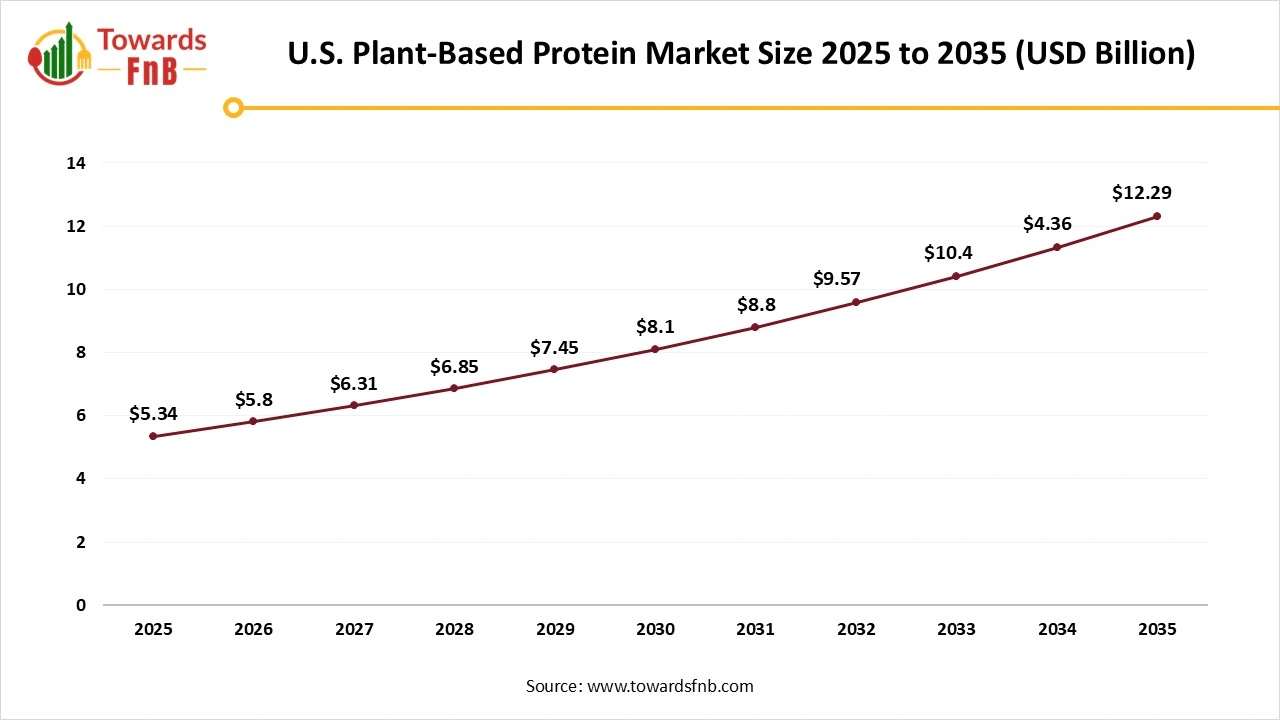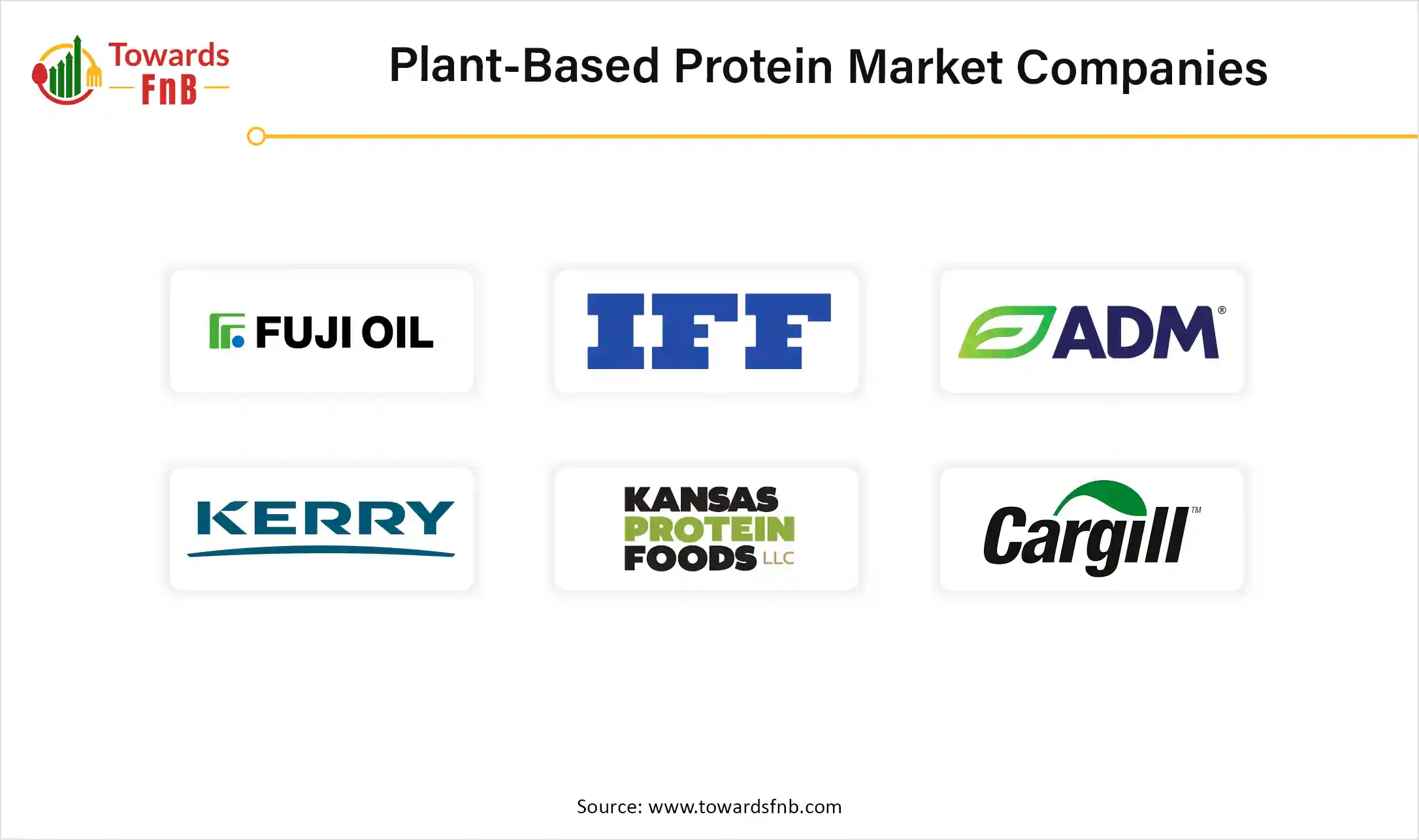December 2025
The global plant-based protein market size estimated at USD 20.33 billion in 2025 and is expected to grow steadily from USD 22.10 billion in 2026 to reach nearly USD 46.82 billion by 2035, with a CAGR of 8.7% during the forecast period from 2026 to 2035. The rising adoption of vegan and vegetarianism in people which causes the increased demand for the vegetarian food and clean source of protein accelerate the growth of the market.

| Study Coverage | Details |
| Growth Rate from 2026 to 2035 | CAGR of 8.7% |
| Market Size in 2026 | USD 22.10 Billion |
| Market Size in 2027 | USD 24.02 Billion |
| Market Size by 2035 | USD 46.82 Billion |
| Largest Market | North America |
| Base Year | 2025 |
| Forecast Period | 2026 to 2035 |
| Regions Covered | North America, Europe, Asia-Pacific, Latin America, and Middle East & Africa |
The proteins that are derived from plant sources are plant-based proteins. Proteins like soy, tempeh, tofu, peas, hemp, and many more are types of plant-based protein. Growing ethical concerns about animal welfare, allergies, and lactose intolerance drive the growth of the market. Consumers are widely looking for alternative sources of meat and meat products. Factors like consumer interest in health-conscious food & beverages, wide adoption of veganism & major innovation in food products drives the market growth.
Consumers are more aware of what they are eating. Consumers are giving preference for vegetarian or vegan food due to ethical concerns. People choose a vegan lifestyle for numerous reasons such as environmental sustainability, health benefits, and many more reasons. A vegan & vegetarian diet reduces the risk of high blood pressure, diabetes, heart disease, obesity, and certain types of cancer. They have less cholesterol and saturated fats.
The fiber content in a plant-based diet is high due to this it is easy to digest. Plant-based protein promotes good gut health, and it takes less time to digest. Some consumers believe that animals have the right to live their lives, and they choose vegan life. Plant-based diets are sustainable for the environment, and they reduce pollution also. The plant-based food industry innovated new products for their consumer. Vegetarianism and veganism a key driving factors for the plant-based protein industry.

Innovating new sources of plant-based protein is a major opportunity for the plant-based protein industry. Plant-based industries can focus on improving processing technologies, creating more sustainable alternatives, and finding new sources of protein. Plant-based industries can innovate new protein powders, protein bar, and beverages using natural sources like legumes, hemp proteins, and many more. Consumers always search for a healthier option that can help manufacturers innovate new products and technology to enhance the lifestyle of consumers.
Manufacturers can create 3D printing technology to provide more customized structures and textures to users. Focus on innovating the tastes, appearance, and texture of food products to make them more attractive to consumers. Innovating new sources that will avoid nutritional deficiency among consumers is needed. In the future, innovations in plant-based protein technology will help in the growth of the market.
With the several benefits related to the plant-based protein, there are some constraints like side effects that originated in some cases by the consuming plant-based protein like digestive discomfort, gas, bloating, kidney issues, and allergies which limits the adaptation of products, and the hormonal imbalance causes by the excessive consumption of plant based protein is also one of the leading factor that hampers the market growth.
North America Takes Over Plant-Based Protein Industry
North America dominated the plant-based protein market in 2025. The rising vegan population, fitness culture, and established food and beverage section fuel the growth of the market. The regional consumers are looking for alternatives to traditional meat. The growing health awareness and dietary habits help in the growth of the market. The modern lifestyle of consumers raises the need for healthy protein-rich and digestible food. Additionally, the innovation of the region in food technology and established distribution channels extends the market.
The North America plant-based protein market size was calculated at USD 7.12 billion in 2025 with projections indicating a rise from USD 7.74 billion in 2026 to approximately USD 16.39 billion by 2035, expanding at a CAGR of 8.7% throughout the forecast period from 2026 to 2035.
 How Big is U.S. Plant-Based Protein Market?
How Big is U.S. Plant-Based Protein Market?
United States leads the plant-based market In the U.S. due to well-established research and development, strong economic growth, and a focus on health and wellness. The growing vegan population in the region influences the growth of the market. The US continuously innovates new technology regarding protein extraction and processing methods driving the growth of the market.
The U.S. plant-based protein market size reached at USD 5.34 billion in 2025 and is anticipated to increase from USD 5.8 billion in 2026 to an estimated USD 12.29 billion by 2035, witnessing a CAGR of 8.7% during the forecast period from 2026 to 2035.

Plant-Based Protein Industry Transforms Asia Pacific
Asia Pacific Expects the Fastest Growth in the Market During the Forecast Period. Growing awareness about protein-rich foods, increasing vegan population, and rising health consciousness drive the growth of the market in the region. Increasing population and rising disposable income help in market growth. Countries in the regions are looking for plant-based meat alternatives. Some people in the region are lactose intolerant and causes the higher demand plant-based alternatives which boosts the growth of the market in the region.

China dominates the plant-based protein market in the Asia Pacific region. The rising population in the country is one of the factors for the growth of the market. The Chinese government took the initiative to promote plant-based proteins among consumers. The production of soybean and wheat in the country builds a strong foundation for the market. Rising health consciousness and environmental awareness drive the growth of the market.
Plant-Based Protein Market Size By Region, 2024 to 2034 (USD Billion)
| By Region | 2024 | 2025 | 2026 | 2027 | 2028 | 2029 | 2030 | 2031 | 2032 | 2033 | 2034 |
| North America | 6.54 | 7.03 | 7.56 | 8.12 | 8.72 | 9.36 | 10.06 | 10.8 | 11.59 | 12.44 | 13.35 |
| Asia Pacific | 5.61 | 6.18 | 6.81 | 7.49 | 8.25 | 9.08 | 9.99 | 11 | 12.1 | 13.31 | 14.64 |
| Europe | 4.67 | 5.06 | 5.48 | 5.93 | 6.42 | 6.95 | 7.53 | 8.15 | 8.82 | 9.55 | 10.34 |
| Middle East & Africa | 0.94 | 1.04 | 1.15 | 1.27 | 1.41 | 1.56 | 1.73 | 1.91 | 2.11 | 2.34 | 2.58 |
| Latin America | 0.94 | 1.02 | 1.1 | 1.2 | 1.31 | 1.42 | 1.54 | 1.68 | 1.82 | 1.98 | 2.15 |
The Soy Protein Segment Dominated the Plant-Based Protein Market in 2024.
The high protein content, affordability, and diverse applications in the food industry drive the growth of the market. Soy protein reduces cholesterol and has numerous nutritional benefits. Soy protein is a great alternative to meat and & dairy due to this it’s dominating the food and beverage industry. Whereas pea protein segment witnesses the fastest growth during the forecast period. The naturally gluten-free and lactose-free quality of peas fuels the growth of the market. Pea protein provides great digestion and consists of amino acids.
Furthermore, ingredients used in a variety of products such as protein powder, protein bars & beverages drive the growth of the market. Innovations in the food processing industry to enhance the taste and quality fuel the growth of the market. It causes a lower environmental impact than other varieties of proteins.
Plant-Based Protein Market Size By Type, 2024 to 2034 (USD Billion)
| By Type | 2024 | 2025 | 2026 | 2027 | 2028 | 2029 | 2030 | 2031 | 2032 | 2033 | 2034 |
| Soy Protein | 8.41 | 8.98 | 9.59 | 10.23 | 10.91 | 11.64 | 12.4 | 13.21 | 14.07 | 14.98 | 15.93 |
| Pea Protein | 4.67 | 5.22 | 5.83 | 6.51 | 7.26 | 8.09 | 9.01 | 10.03 | 11.15 | 12.4 | 13.78 |
| Rice Protein | 1.5 | 1.65 | 1.81 | 1.99 | 2.19 | 2.41 | 2.65 | 2.92 | 3.21 | 3.53 | 3.88 |
| Hemp Protein | 0.94 | 1.08 | 1.24 | 1.42 | 1.62 | 1.84 | 2.1 | 2.38 | 2.7 | 3.05 | 3.45 |
| Wheat Protein | 1.87 | 1.95 | 2.03 | 2.11 | 2.19 | 2.27 | 2.34 | 2.41 | 2.48 | 2.54 | 2.58 |
| Others | 1.31 | 1.44 | 1.59 | 1.75 | 1.93 | 2.13 | 2.34 | 2.58 | 2.84 | 3.13 | 3.45 |
The Food & Beverages Segment Holds the Largest Share of the Plant-Based Protein Market in 2024.
The rising demand for meat and dairy alternatives drives the growth of the market. Soy, peas, and many more types of plant proteins are used in departments like bakeries, beverages, and snacks. The rising consumer demand for protein-rich food helps in the growth of the market. Consumer's awareness of clean-label and natural ingredients fuels the market growth. Whereas the supplement segment is anticipated fastest growing market during the forecast period.
The availability of protein powder and nutritional supplements to complete dietary and fitness goals helps in the growth of the market. The growing demand for plant-based protein among sportspersons, athletes, and fitness enthusiasts drives the growth of the market. Manufacturers create personalized and specialized supplement formulations for consumers. Additionally, the segment is benefiting due to rising consumer awareness about healthy lifestyles.
Plant-Based Protein Market Size By End Use, 2024 to 2034 (USD Billion)
| By End Use | 2024 | 2025 | 2026 | 2027 | 2028 | 2029 | 2030 | 2031 | 2032 | 2033 | 2034 |
| Food & Beverages | 13.09 | 14.11 | 15.2 | 16.38 | 17.65 | 19.01 | 20.48 | 22.06 | 23.76 | 25.59 | 27.56 |
| Supplements | 2.8 | 3.11 | 3.45 | 3.82 | 4.23 | 4.68 | 5.18 | 5.73 | 6.34 | 7.01 | 7.75 |
| Personal Care & Cosmetics | 0.94 | 1.04 | 1.15 | 1.27 | 1.41 | 1.56 | 1.73 | 1.91 | 2.11 | 2.34 | 2.58 |
| Animal Food | 1.87 | 2.07 | 2.3 | 2.55 | 2.82 | 3.12 | 3.45 | 3.82 | 4.23 | 4.68 | 5.17 |

By Type
By End Use
By Region
December 2025
December 2025
December 2025
December 2025